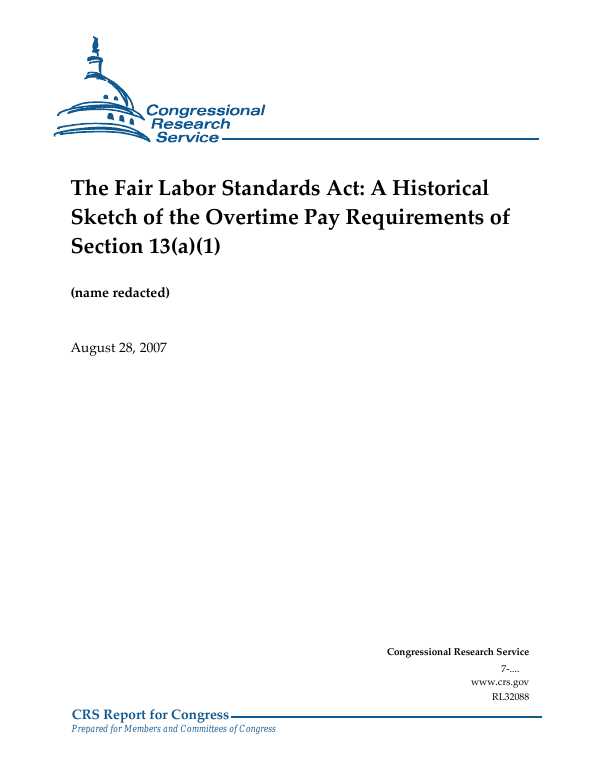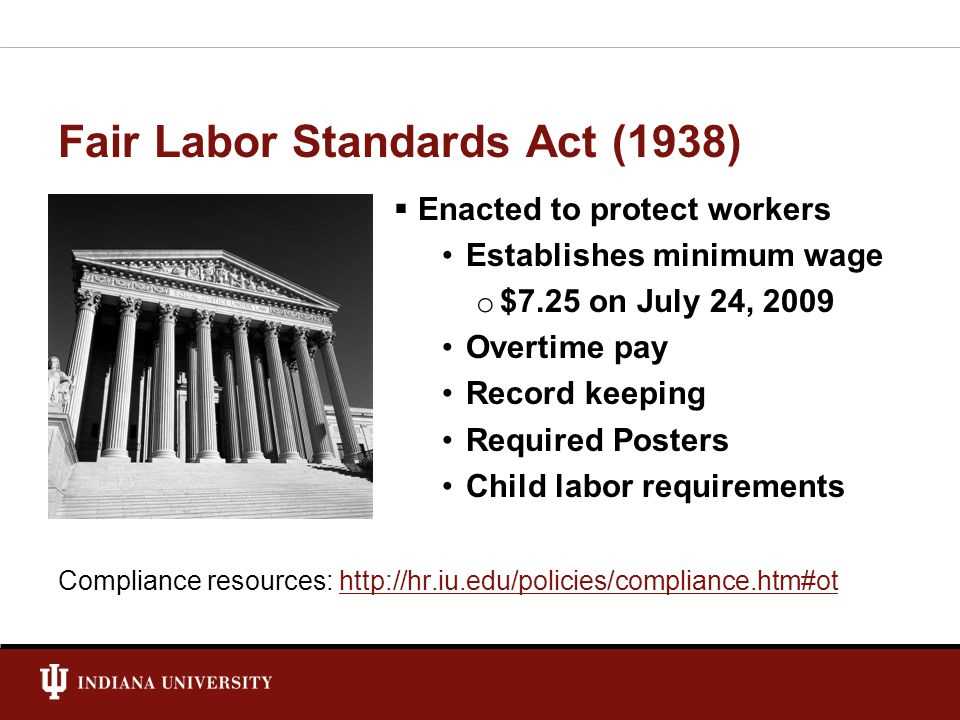Fair Labor Standards Act: A Comprehensive Overview and Historical Background

The Fair Labor Standards Act (FLSA) is a federal law in the United States that establishes minimum wage, overtime pay, recordkeeping, and child labor standards affecting full-time and part-time workers in the private sector and in federal, state, and local governments. It was enacted on June 25, 1938, and is administered by the Wage and Hour Division of the U.S. Department of Labor.
The FLSA was created in response to widespread labor exploitation and unfair working conditions during the Great Depression. It aimed to protect workers from exploitation and ensure fair compensation for their labor. The law sets a minimum wage, currently $7.25 per hour, which employers must pay to covered employees. It also requires employers to pay overtime wages, at a rate of one and a half times the regular rate, for hours worked beyond 40 in a workweek.
In addition to establishing minimum wage and overtime pay, the FLSA also regulates child labor. It sets specific age requirements and restrictions on the types of work that minors can perform. The law aims to protect the health, safety, and educational opportunities of young workers by limiting their employment in hazardous occupations and ensuring they have adequate time for schooling.
The FLSA has undergone several amendments and updates since its enactment in 1938. These changes have expanded the scope of the law, increased minimum wage rates, and strengthened protections for workers. For example, the FLSA was amended in 1974 to extend its coverage to state and local government employees, and in 2009, the federal minimum wage was increased to $7.25 per hour.
Overall, the Fair Labor Standards Act plays a crucial role in protecting the rights and well-being of workers in the United States. It ensures that employees receive fair compensation for their work, promotes safe and healthy working conditions, and safeguards the educational opportunities of young workers. Employers must comply with the provisions of the FLSA to avoid legal penalties and ensure a fair and equitable workplace.
Historical Background of the Fair Labor Standards Act
The Fair Labor Standards Act (FLSA) is a landmark piece of legislation that was enacted in 1938 by the United States Congress. It was designed to establish minimum wage, overtime pay, recordkeeping, and child labor standards for employees in the private sector, as well as in federal, state, and local governments.
The FLSA was a response to the widespread exploitation of workers during the Great Depression. At the time, many employers were taking advantage of the economic downturn by paying their employees extremely low wages and forcing them to work long hours without any compensation for overtime.
Prior to the FLSA, there were no federal laws regulating minimum wage or overtime pay. Some states had their own laws in place, but they were often ineffective and lacked enforcement mechanisms. As a result, millions of workers were living in poverty and struggling to make ends meet.
The FLSA aimed to address these issues by establishing a federal minimum wage, initially set at 25 cents per hour, and a maximum workweek of 44 hours. It also mandated that employers pay their employees time and a half for any hours worked beyond the maximum workweek.
Additionally, the FLSA included provisions to protect children from exploitation in the workplace. It set minimum age requirements for employment and restricted the types of hazardous occupations that minors could be employed in.
Over the years, the FLSA has been amended and expanded to provide additional protections for workers. The minimum wage has been increased several times, and the maximum workweek has been reduced to 40 hours. The FLSA also includes provisions for equal pay and prohibits retaliation against employees who exercise their rights under the law.
Today, the FLSA continues to play a crucial role in ensuring fair labor practices and protecting the rights of workers in the United States. It serves as a foundation for labor laws and regulations at both the federal and state levels, and its impact can be seen in the improved working conditions and wages that many employees enjoy today.
Comprehensive Overview of the Fair Labor Standards Act

The Fair Labor Standards Act (FLSA) is a federal labor law in the United States that establishes minimum wage, overtime pay, recordkeeping, and child labor standards for employees in the private sector as well as in federal, state, and local governments. Enacted in 1938, the FLSA was designed to protect workers from unfair labor practices and ensure they receive fair compensation for their work.
Minimum Wage:
One of the key provisions of the FLSA is the establishment of a federal minimum wage. The current federal minimum wage is $7.25 per hour, although individual states may have higher minimum wage rates. The FLSA sets the standard for minimum wage and ensures that employees are paid at least this amount for their work.
Overtime Pay:
The FLSA also requires employers to pay eligible employees overtime pay for any hours worked beyond 40 hours in a workweek. Overtime pay must be at least one and a half times the employee’s regular rate of pay. However, certain exemptions exist for specific types of employees, such as executives, professionals, and certain administrative employees.
Recordkeeping:
Under the FLSA, employers are required to keep accurate records of employees’ hours worked, wages paid, and other employment-related information. This ensures transparency and allows employees to verify that they are being paid correctly and in accordance with the law.
Child Labor:
The FLSA also includes provisions to protect the rights of child workers. It sets limitations on the types of work that minors can perform, the hours they can work, and the wages they can receive. These regulations are in place to prevent exploitation and ensure the well-being of young workers.
Enforcement and Penalties:
The Department of Labor’s Wage and Hour Division (WHD) is responsible for enforcing the FLSA. Employers found to be in violation of the FLSA may be subject to penalties, including fines and back wages owed to employees. The FLSA provides workers with a legal recourse to address violations and seek compensation for any unpaid wages or other labor law violations.

Emily Bibb simplifies finance through bestselling books and articles, bridging complex concepts for everyday understanding. Engaging audiences via social media, she shares insights for financial success. Active in seminars and philanthropy, Bibb aims to create a more financially informed society, driven by her passion for empowering others.
